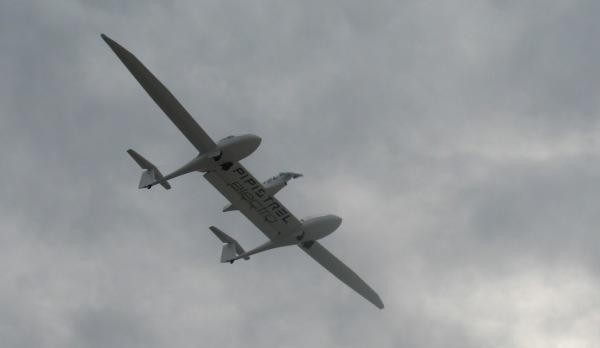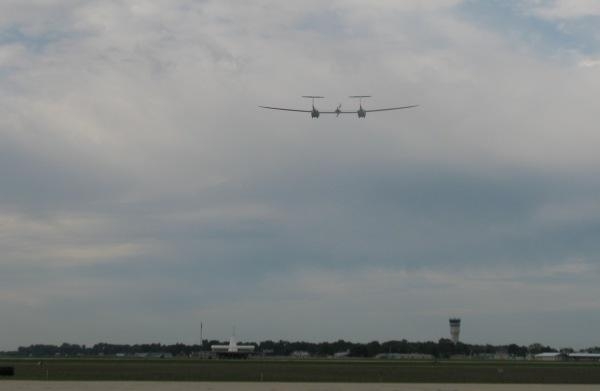Pipistrel Flies The First 4-Seat Electric Aircraft In The
World
The Tarus G4 ... the first 4-seat electric aircraft in the world
... took off Thursday morning at 0700 local time from Wittman Field
in Oshkosh, WI. Pipistrel, the developer of the G4, said the flight
was the result of long and demanding work nearly of a nearly
30-member team of developers and constructors.

The aircraft was developed in order to compete at the next NASA
challenge, called CAFE Green Flight Challenge 2011. This year, the
competition prize pool amounts to $ 1.65 million dollars. The
competition will be held during the fifth annual CAFE Electric
Aircraft Symposium held in Santa Rosa, California.
The aircraft was first presented to the public at the Oshkosh
Airventure in July this year. According to the informal vote by the
visitors, it was the 9th most attractive aircraft on display among
15,000 exhibited airplanes. Each year, the EAA awards a virtual
“Dead Grass Award” prize (for the most viewed exhibit)
to the ten aircraft with most votes.
But everything was not so easy. The electric propulsion
represents an unknown factor so it presented quite some trouble for
Pipistrel. It was a great challenge even to import the aircraft
into the United States because it is powered by 450 pounds of
lithium-polymer batteries, which can in certain circumstances be
highly flammable. It was also extremely difficult to find an
insurance company in the U.S. which was prepared to insure such
aircraft.

The company also had to find an
American test pilot - the FAA requests that the first test flights
must be performed by an American test pilot and CAFÉ
competition rules also demand an American pilot to fly the aircraft
at the race. Fortunately, the Taurus G4 received huge media
interest during the exhibition in Oshkosh, so consequentially, the
team managed to find an insurance company and convince it to accept
the insurance challenge.
After the Airventure expo, when the huge airport complex
emptied, the friendly airport crew allowed Pipistrel to use the
airport hangar and runway for testing. Thus the Pipistrel
team achieved the historic flight Thursday morning.

Pipistrel's new, twin-fuselage plane
was created by combining two Taurus G2 fuselages, connected by a
5-meter-long spar. A 145-kilowatt brushless electric motor,
developed for the new Pipistrel's 4-seat aircraft Panthera, is
mounted between the passenger pods and drives a six-foot-diameter,
two-blade propeller in tractor configuration. Taurus 4’s full
wingspan is about 75 feet. The undercarriage is retractable which
enables good gliding ratio and low drag, paramount for the success
at the competition. Despite not being intended as a glider, the
superb aerodynamic profile gives the G4 an edge over the
competition, since the goals of the challenge are mostly
aeroefficiency and economic flight.
“The Taurus G4 NASA Racer is a technology
demonstrator,” said Tine Tomažic, Pipistrel development
engineer and the leader of the G4 development team. “It is
the first-ever electric four-place aircraft, the most powerful
electric aircraft with most battery capacity on board.” He
declined to disclose just what that capacity is (it is a race
secret), nor did he disclose the aircraft’s “very high
glide ratio” other than to say it’s more than 30 at
cruise speed (100 mph). These and other aircraft details will be
released at the GFC, he said.
All components of the aircraft have been developed and made by
Pipistrel. Aerodynamic studies have been entrusted to prof. dr.
Gregor Veble, Head of Research at Pipistrel. The construction of
the aircraft was accomplished by dr. Vid Plevnik in cooperation
with engineer Rado Kikelj. The development of composite technology
parts and systems was done by Sašo Kolar and Franci
Popit with their teams. The most challenging part, namely the
development of electronic systems and their regulation as well as
the system for charging the batteries were developed by engineer
Jure Tomažic with his team.

 Unfortunate... ANN/SportPlane Resource Guide Adds To Cautionary Advisories
Unfortunate... ANN/SportPlane Resource Guide Adds To Cautionary Advisories ANN FAQ: Turn On Post Notifications
ANN FAQ: Turn On Post Notifications ANN's Daily Aero-Term (04.29.24): Visual Approach Slope Indicator (VASI)
ANN's Daily Aero-Term (04.29.24): Visual Approach Slope Indicator (VASI) ANN's Daily Aero-Term (04.28.24): Airport Marking Aids
ANN's Daily Aero-Term (04.28.24): Airport Marking Aids ANN's Daily Aero-Linx (04.28.24)
ANN's Daily Aero-Linx (04.28.24)






